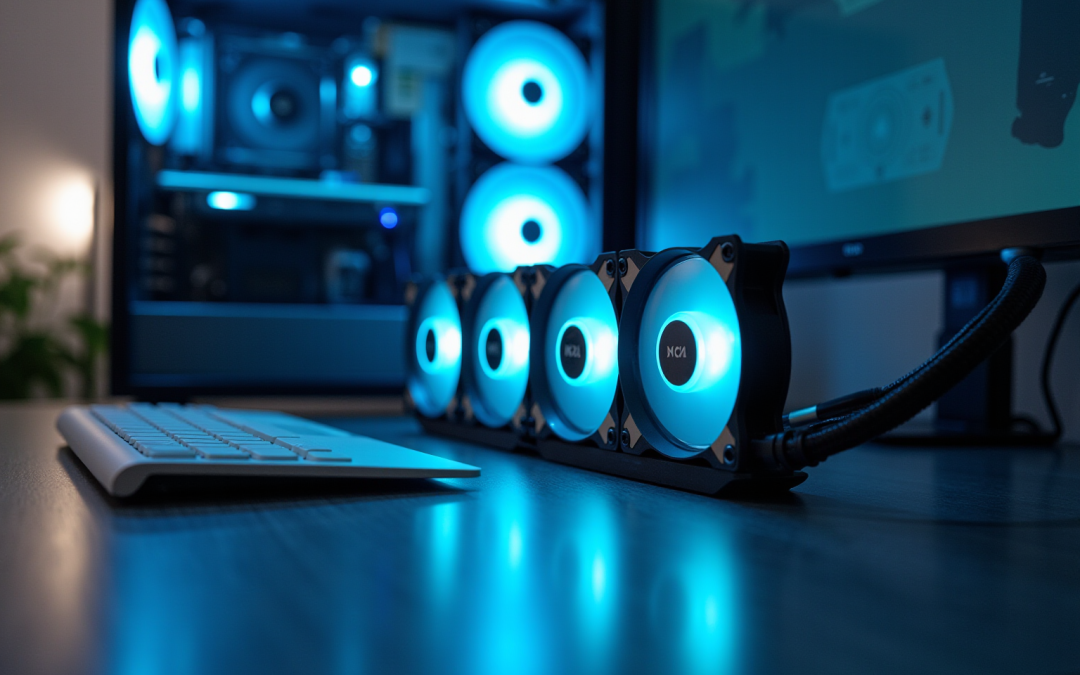Overview
The article titled “Computer Fan Sizes Chart: Essential Options for Engineers” addresses the critical aspect of selecting the appropriate computer fan sizes for various cooling applications in engineering. It asserts that 120 mm fans serve as the standard choice for most PC cooling needs, striking an optimal balance between airflow and noise levels. In contrast, larger fans, such as 140 mm and 200 mm, provide enhanced airflow, catering to high-performance systems. This underscores the necessity of choosing the right fan size tailored to specific thermal management requirements, ultimately guiding engineers to make informed decisions in their cooling solutions.
Introduction
Understanding the intricacies of computer fan sizes is essential for engineers striving to optimize thermal management in electronic systems. As technology advances and devices become more compact, the choice of fan size directly impacts airflow efficiency and noise levels, making it a critical consideration in design.
Engineers face significant challenges when selecting the right fan size, and the computer fan sizes chart serves as a valuable tool in making informed decisions. This article delves into the various fan sizes available, highlighting their unique benefits and applications, thereby empowering engineers in their cooling solutions.
Gagner-Toomey Associates: Leading Provider of Cooling Solutions for Electronics
Gagner-Toomey Associates stands out as a premier supplier of advanced temperature management systems specifically designed for the electronics sector. By collaborating with leading manufacturers, the company prioritizes innovative technologies that significantly improve the performance and reliability of electronic systems.
Current trends indicate a shift toward high-end liquid temperature management and energy-efficient technologies, driven by the increasing power density in data centers and the miniaturization of electronic devices. Notably, statistics reveal that approximately 55% of the total energy consumed in data centers is allocated to maintaining IT equipment temperature, underscoring the critical need for .
Industry leaders assert that AI-driven optimization of temperature regulation can reduce energy consumption by up to 40%, illustrating the transformative potential of innovative climate control technologies in the electronics sector.
Gagner-Toomey’s commitment to addressing complex engineering challenges positions them as a trusted partner for professionals seeking reliable and efficient temperature regulation solutions.
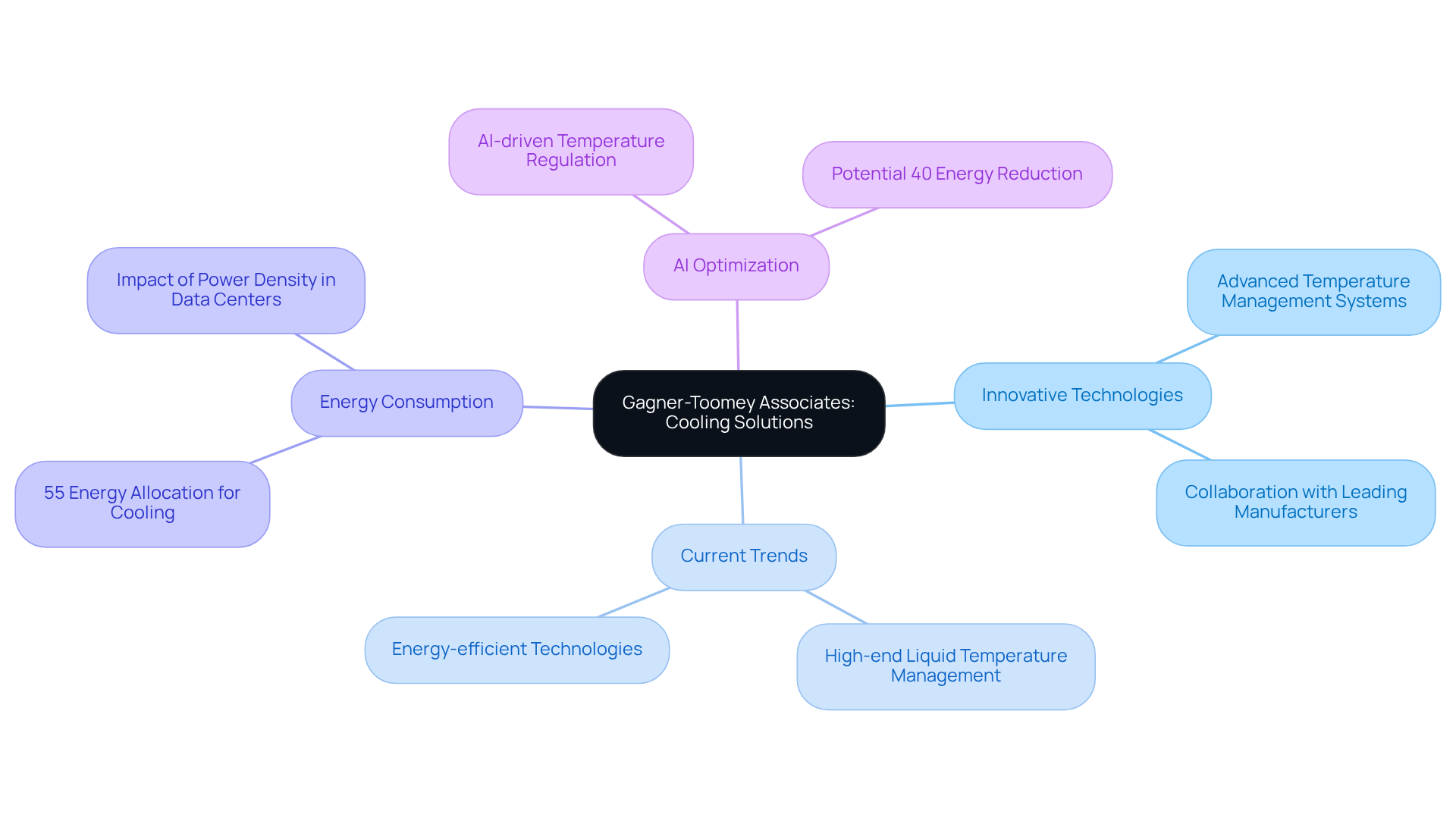
120 mm Fans: The Standard Choice for PC Cooling
The computer fan sizes chart indicates that 120 mm units serve as the standard for PC temperature management, striking an ideal balance between ventilation and noise levels. Operating within a speed range of 1200 to 2000 RPM, these devices deliver adequate cooling for a variety of configurations, from gaming setups to professional workstations. Their dimensions facilitate straightforward installation in most scenarios, enhancing their versatility.
Engineers recognize the benefits of 120 mm units, as detailed in the computer fan sizes chart, noting their ability to provide efficient ventilation while remaining quieter than both larger and smaller alternatives. Recent evaluations spotlight models like the Corsair iCUE QL120 RGB units, which achieve a maximum ventilation of 41.8 CFM at a noise level of only 26 dBA, making them a preferred choice among enthusiasts.
Furthermore, the be quiet! Pure Wings 2 fan has garnered praise for its silent operation, boasting a peak noise level of 19.2 dBA and an airflow of 51 CFM. This further cements the 120 mm fan’s status as the benchmark for efficient and effective temperature management in electronics, according to the .
Gagner-Toomey Associates presents an extensive array of temperature regulation options, including standard and custom DC input tube axial devices and centrifugal blowers, optimized for performance and efficiency. Their innovative thermal management solutions, such as extruded aluminum heatsinks and integrated cooling systems, solidify Gagner-Toomey’s reputation as a leading provider in the electronics cooling industry, ensuring engineers have access to premier tools for effective and efficient cooling solutions.
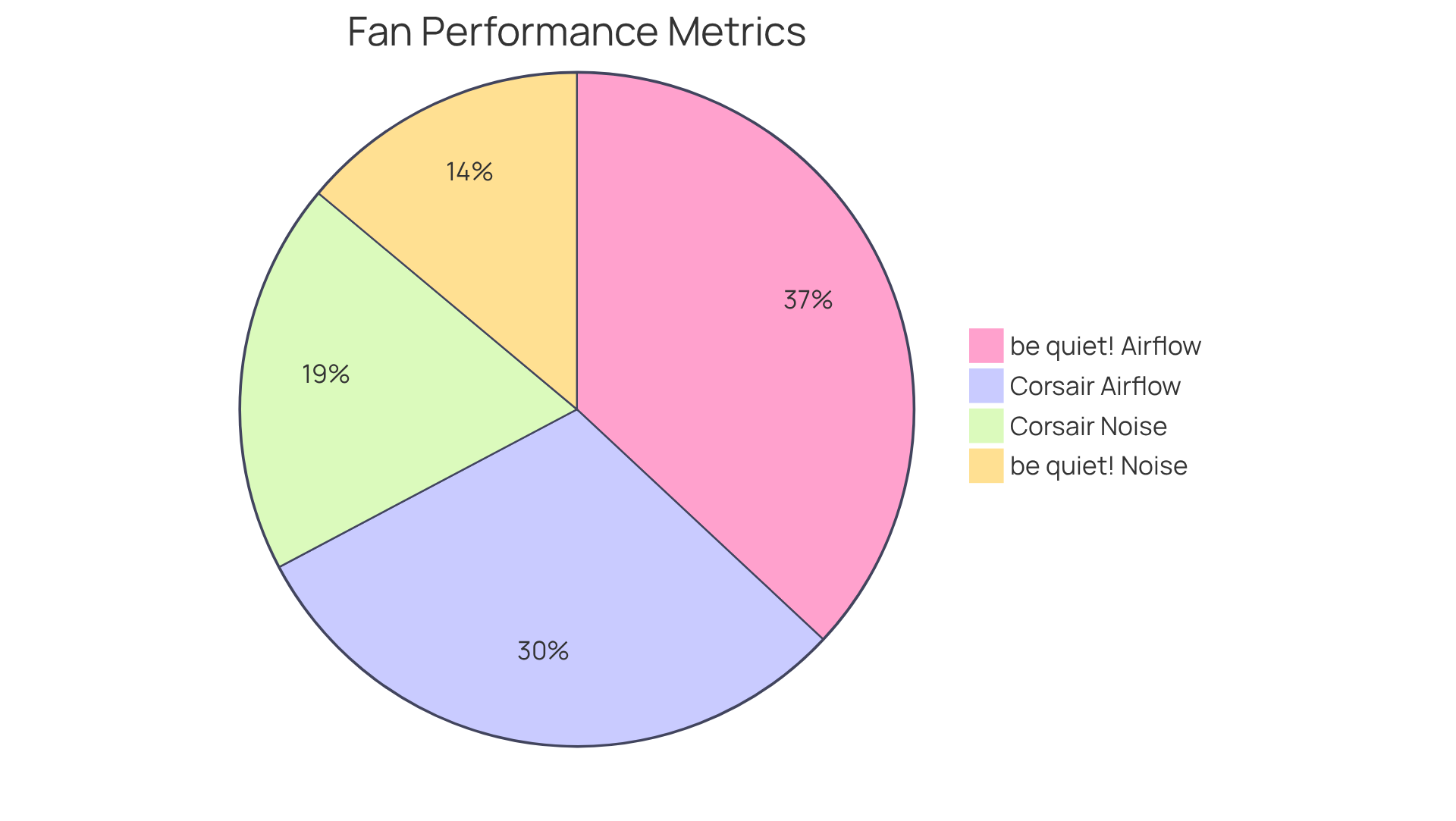
140 mm Fans: Enhanced Airflow for Optimal Performance
140 mm units are engineered to deliver superior airflow compared to their 120 mm counterparts, making them particularly advantageous for high-performance systems. These devices operate within a typical RPM range of 1000 to 1800, effectively moving larger volumes of air while keeping noise levels low. This capability is crucial in setups requiring efficient thermal management, such as overclocked CPUs and high-performance graphics cards.
Gagner-Toomey Associates offers a comprehensive selection of DC input devices, including 140 mm options that are optimized for both performance and efficiency, ensuring engineers have reliable thermal management solutions tailored to their specific requirements. For instance, the Noctua NF-A14, boasting an impressive rotational speed of up to 3000 RPM and an MTBF rating exceeding 70,000 hours, illustrates how 140 mm devices can significantly enhance cooling performance and reliability.
Additionally, the Cooler Master Mobius 140P, recognized for its RGB illumination and ventilation efficiency, operates at a peak speed of 1900 RPM, showcasing both the aesthetic and practical benefits of larger components in modern builds. The enhanced airflow provided by 140 mm units not only bolsters thermal management but also contributes to overall system reliability, rendering them a preferred choice for engineers focused on optimizing performance.
Furthermore, with the adoption of PWM control increasing by 40% annually, the demand for customizable temperature management in high-performance systems is on the rise. Typically, a high-temperature PC requires 2-3 case ventilators for optimal temperature management, which highlights the importance of referencing a to include 140 mm units in comprehensive system thermal strategies.
Gagner-Toomey Associates also provides IP protection in most models upon request, along with a complete range of DC input Tube Axial devices and Centrifugal Blowers, ensuring thorough thermal management options for diverse applications.
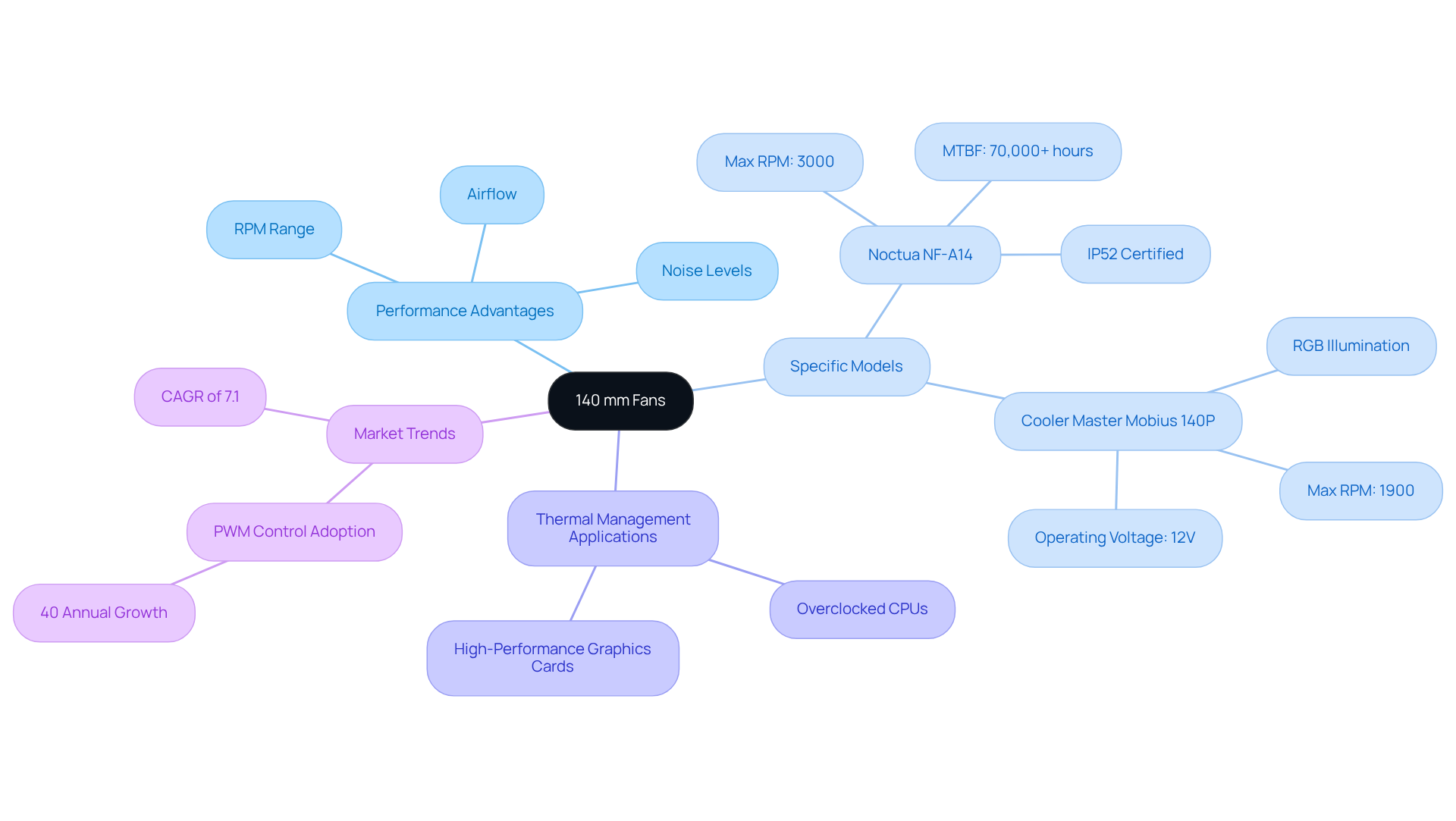
80 mm Fans: Compact Solutions for Space-Constrained Builds
80 mm units represent essential compact thermal management solutions, ideally suited for space-constrained environments such as small form factor PCs and embedded systems. Operating at speeds typically ranging from 2000 to 4000 RPM, these devices deliver efficient ventilation while fitting into limited spaces. Their design proves particularly beneficial in scenarios where every millimeter is critical, enabling engineers to optimize thermal management without sacrificing performance. Users have noted that these devices maintain adequate cooling even within high-density environments, making them a preferred choice for modern computing needs.
In practical applications, 80 mm cooling devices frequently find use in:
- Gaming setups
- Compact workstations
- Networking equipment
where effective ventilation is paramount. With an of approximately 40 to 70 CFM, they achieve a commendable balance between size and performance, ensuring reliable operation under demanding conditions. Notably, Gagner-Toomey Associates offers a range of 80 mm units tailored for performance, efficiency, and low noise, including models designed to deliver high airflow ratings while minimizing sound levels.
For example, the Evercool EC8038H12B fan operates at 67.1 CFM while generating a noise level of 43.8 dBA, making it an excellent option for engineers prioritizing quieter operation. Furthermore, the lifespan of 80 mm units varies based on materials; plastic models generally last 3 to 5 years, whereas metal versions can endure for up to 10 years or longer. As engineers continue to innovate compact designs, the significance of 80 mm blowers remains vital in achieving effective thermal management solutions, supported by Gagner-Toomey’s extensive portfolio of standard and custom thermal products.
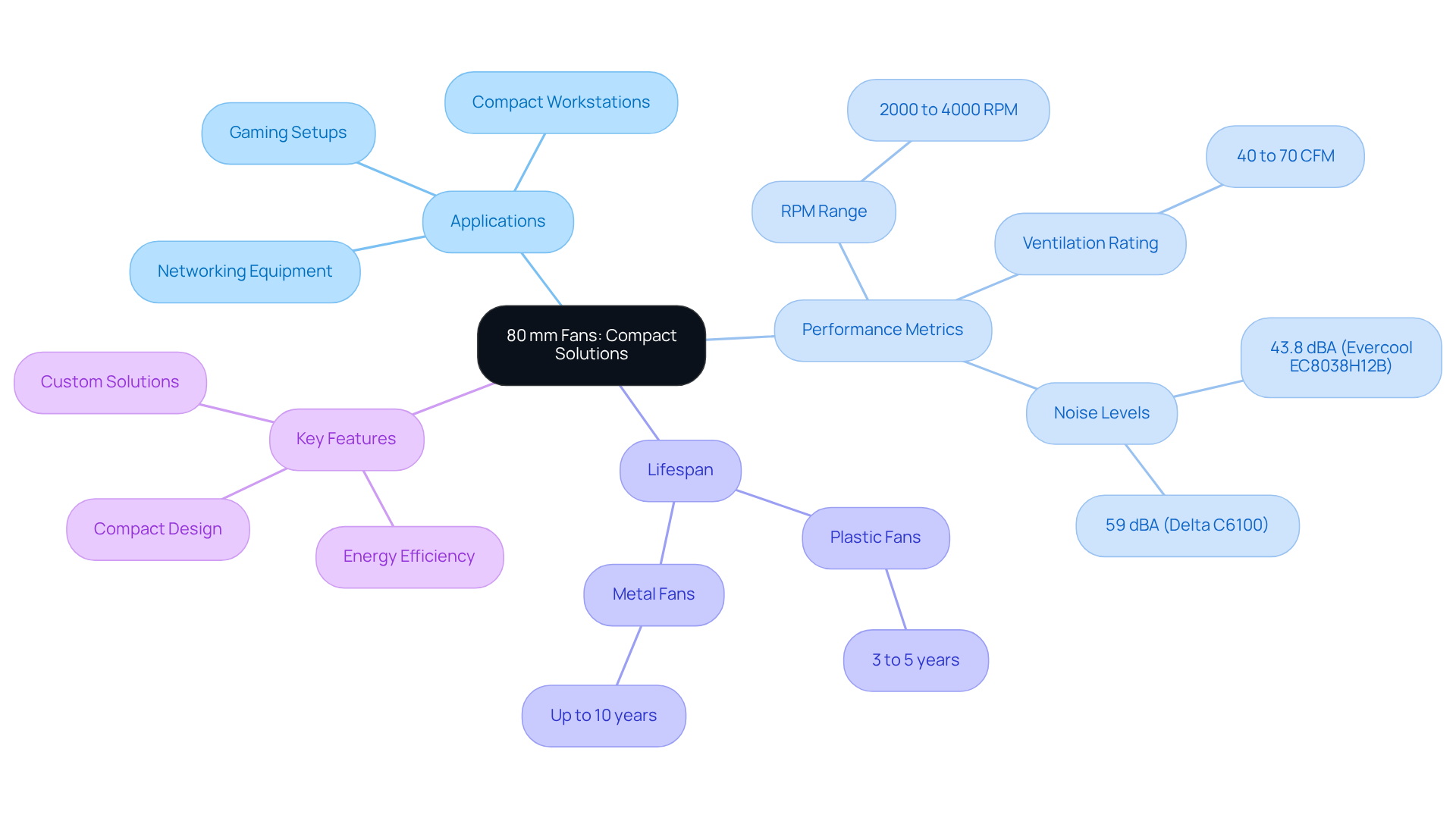
200 mm Fans: High Airflow for Large Cases
200 mm blowers are engineered for high airflow applications, making them particularly effective in large enclosures and thermal configurations. Operating within a typical RPM range of 600 to 1200, these devices can displace significant volumes of air while maintaining low noise levels, often around 18 dBA. This characteristic is especially advantageous in systems that require extensive cooling, such as gaming rigs or servers, where is essential.
Industry leaders assert that larger blowers, such as those offered by Gagner-Toomey Associates, not only deliver impressive airflow—up to 76 CFM—but also operate quietly, positioning them as the preferred choice for enthusiasts who seek both performance and tranquility in their builds.
Real-world examples underscore the effectiveness of 200 mm units in gaming setups, which are highlighted in the computer fan sizes chart, where they contribute to enhanced thermal performance and reduced noise compared to smaller models. Research indicates that according to the computer fan sizes chart, 200 mm devices can achieve a superior airflow-to-noise ratio, making them an ideal selection for high-performance configurations.
As the demand for quieter, more efficient temperature regulation solutions grows, the advantages of 200 mm units from Gagner-Toomey Associates become increasingly clear, solidifying their role in modern PC temperature management strategies.
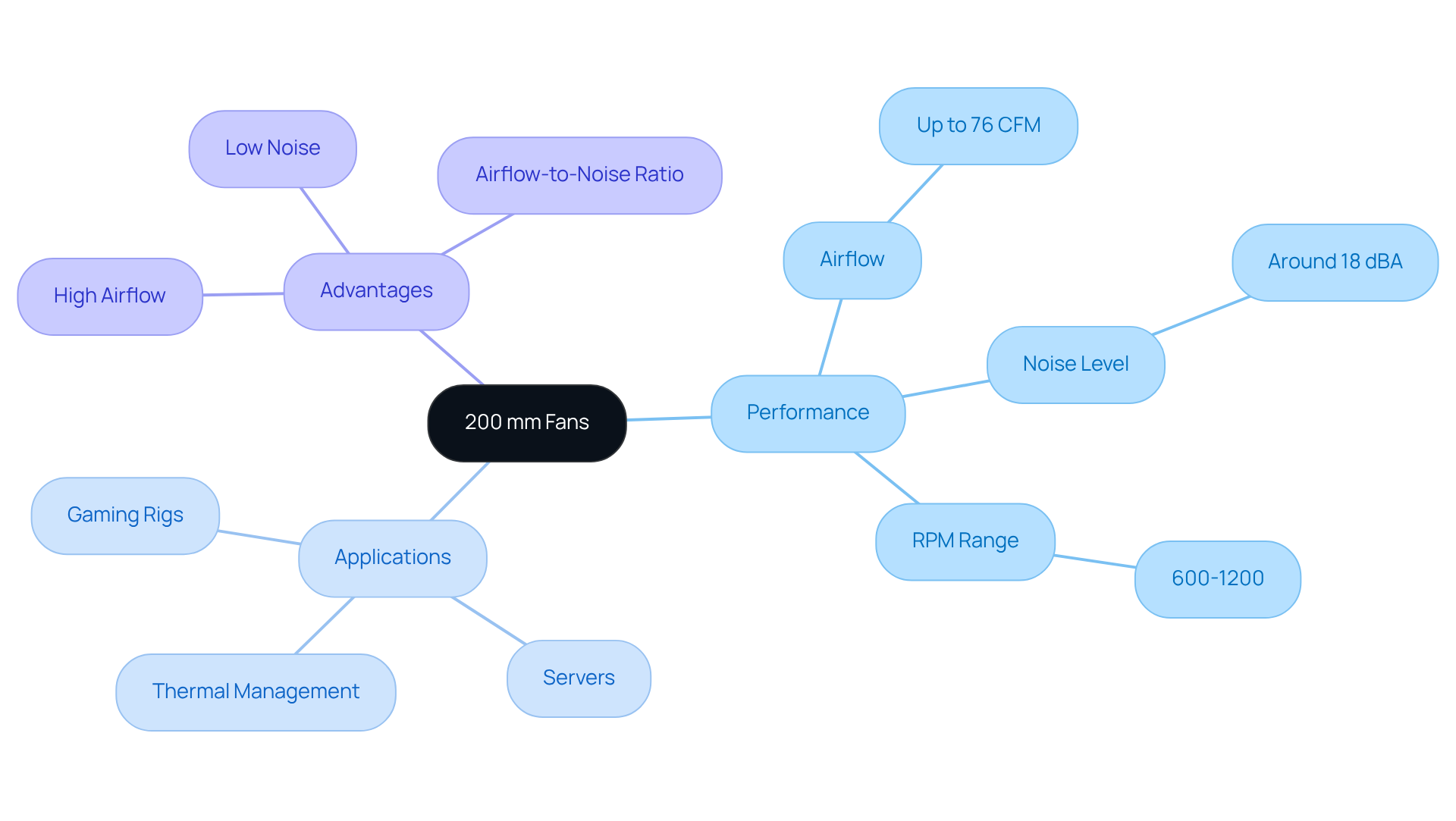
40 mm Fans: Specialized Cooling for Unique Applications
40 mm devices serve as specialized thermal management solutions, particularly in networking equipment, compact PCs, and embedded systems. Operating at speeds exceeding 5000 RPM, these blowers deliver airflow rates of up to 3.3 m³/h, which is essential for maintaining optimal performance in space-constrained devices. Their compact design enables seamless integration into various applications where effective thermal management is critical.
As the world’s largest producer of standard and custom air-movers, Gagner-Toomey Associates offers an extensive range of temperature regulation solutions, featuring 40 mm devices optimized for performance, efficiency, and low noise. Recent innovations in 40 mm temperature control solutions aim to enhance efficiency while reducing noise levels, addressing the increasing demand for quieter computing environments. Engineers emphasize the importance of these small devices, noting that their ability to provide reliable ventilation is vital in preventing overheating and ensuring the longevity of sensitive components.
The real-world applications of 40 mm devices are diverse, ranging from cooling telematics systems in automotive electronics to ensuring airflow in networking equipment. Their rugged construction and low power consumption make them ideal for environments where reliability is paramount. As technology continues to advance, the role of 40 mm cooling devices in enhancing device performance and efficiency remains indispensable.
Moreover, the compact size of these devices facilitates integration into benchtop lab equipment with space limitations, further demonstrating their versatility. With a of approximately 23.6 dBA and an expected lifespan of up to 150,000 hours, Gagner-Toomey’s 40 mm devices are engineered to meet the demanding requirements of contemporary electronics. Additionally, options for IP protection can be provided upon request, ensuring that these devices can be tailored to specific environmental needs.
By incorporating insights from engineers, it is clear that while 40 mm units excel in compactness and quiet operation, they may face ventilation limitations compared to larger models, which engineers must consider when selecting cooling solutions. Practical tips for optimizing ventilation and installation can further enhance their effectiveness across various applications.
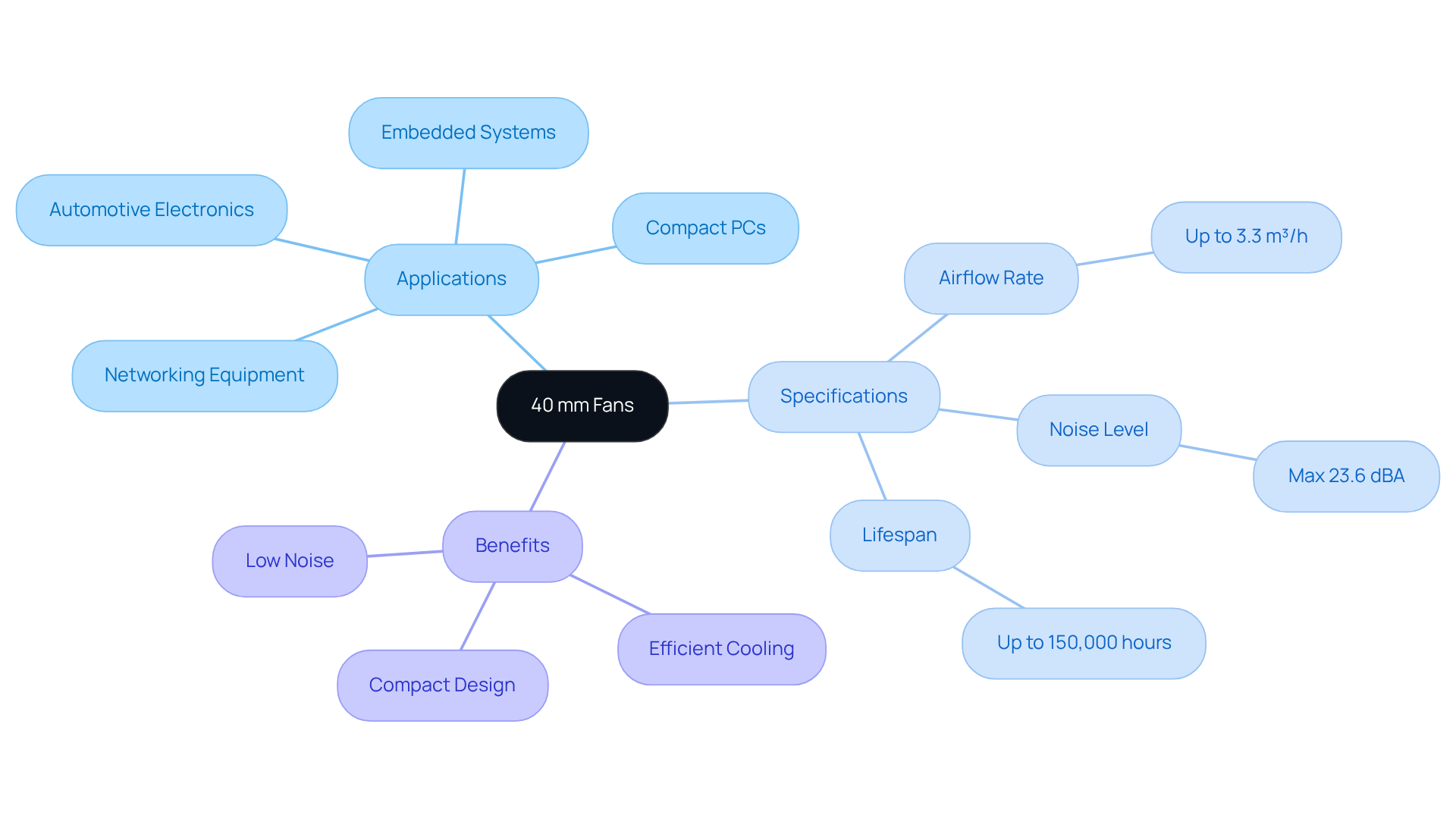
180 mm Fans: Balancing Size and Performance
180 mm units strike an optimal balance between size and performance, making them ideal for various applications. Operating at speeds ranging from 800 to 1600 RPM, these devices deliver impressive airflow while maintaining lower noise levels compared to their smaller counterparts. This efficiency is particularly beneficial in mid-range gaming systems and workstations, where is essential without the distraction of excessive noise.
Gagner-Toomey Associates, the world’s largest producer of standard and custom air-movers, emphasizes that larger units, such as the 180 mm models, can move more air at lower speeds, thereby enhancing overall system performance. In real-world workstation setups, 180 mm cooling units have been shown to significantly improve thermal management, allowing components to operate at optimal temperatures. Their design facilitates quieter operation, making them a preferred choice for environments where noise reduction is crucial.
Furthermore, Gagner-Toomey offers a diverse range of products, including:
- DC input Tube Axial units
- Centrifugal Blowers
These cater to various temperature regulation requirements. The adaptability of 180 mm units renders them a valuable resource in both gaming and professional computing scenarios, underscoring Gagner-Toomey’s commitment to innovative thermal management solutions.
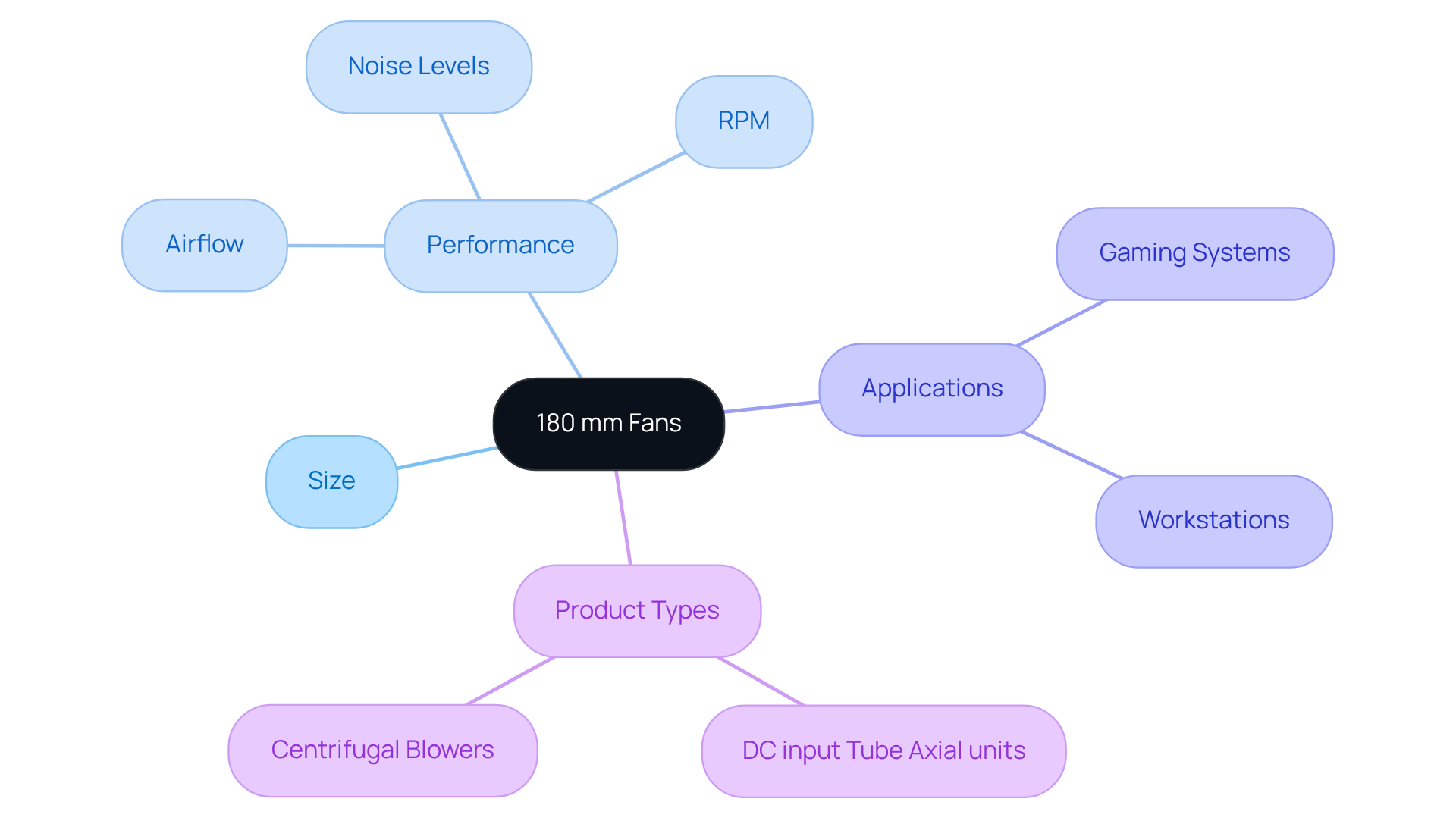
Mini-ITX Case Fans: Tailored Solutions for Small Form Factors
Mini-ITX case ventilators are meticulously engineered to meet the unique constraints of small form factor constructions, typically available in dimensions such as 80 mm or 92 mm. These fans are designed to optimize airflow in confined spaces, often operating at high RPMs—ranging from 2,500 to 4,000 RPM—to ensure that even the most compact systems achieve sufficient thermal performance. The critical role of ventilation in compact builds cannot be overstated; inadequate temperature management can lead to thermal throttling and a shortened system lifespan.
Recent innovations in Mini-ITX thermal management feature advanced blade designs that enhance ventilation efficiency while minimizing noise levels, making them ideal for engineers focused on both performance and acoustics. The practical applications of Mini-ITX components are evident in high-performance gaming setups and compact workstations, where maximizing space without sacrificing temperature control is essential.
As emphasized by industry experts, improving air circulation within these compact designs is vital for maintaining system stability and performance. This underscores the crucial role of in modern engineering applications.
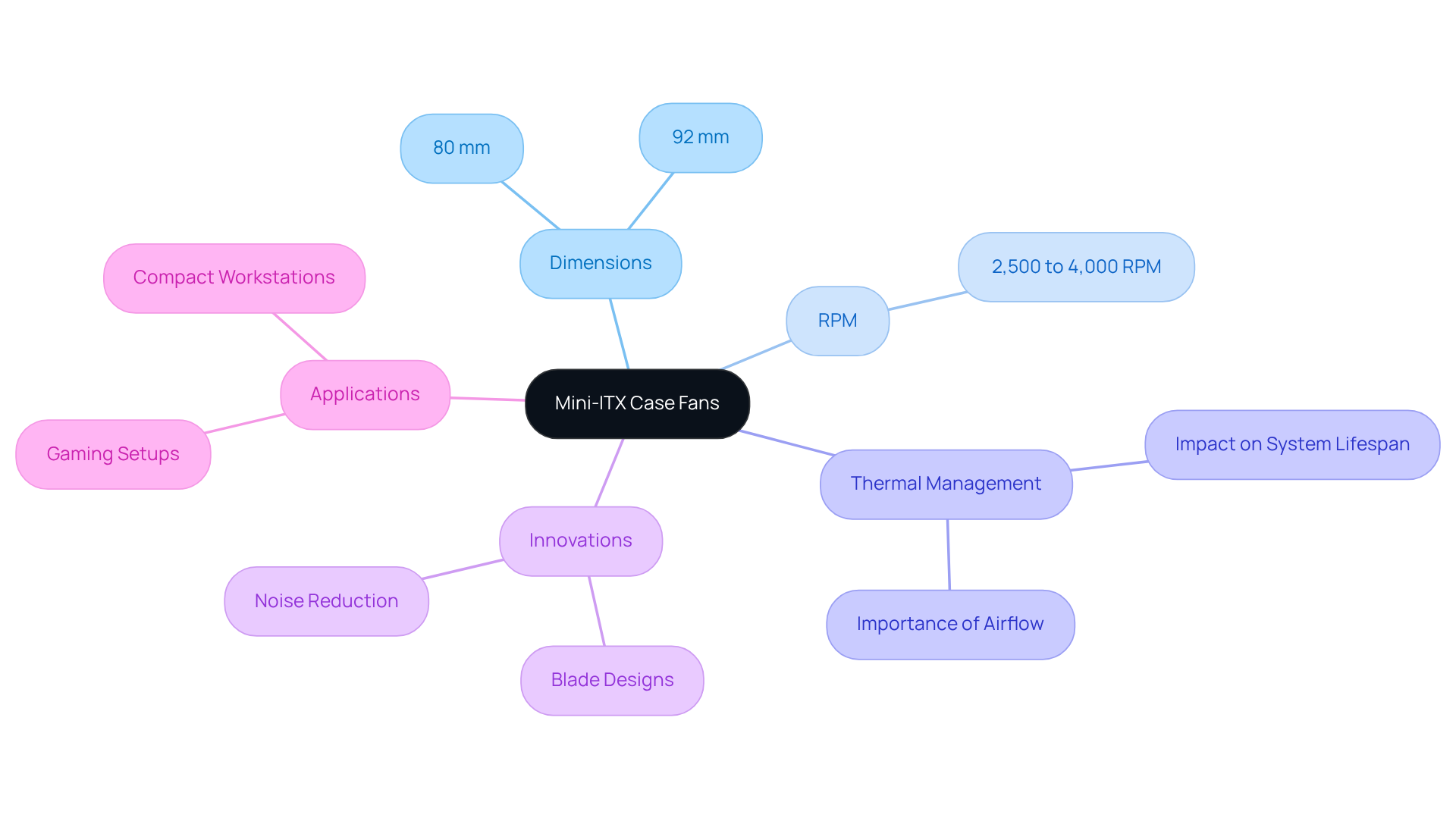
Understanding Fan Dimensions: Impact on Airflow and Cooling Efficiency
Fan dimensions significantly influence air movement and thermal efficiency, making them a critical consideration for engineers. Larger units can move greater volumes of air at lower RPMs, enhancing cooling efficiency while also contributing to quieter operation. Conversely, smaller blowers typically require higher speeds to achieve similar air movement, which results in increased noise levels. This relationship highlights the necessity of selecting the based on specific operational requirements, which can be found in the computer fan sizes chart.
Industry experts assert that the computer fan sizes chart serves as a rough gauge of capacity and performance. For instance, a 12-inch fan from one manufacturer may not perform identically to a 12-inch fan from another, underscoring the variability in wind performance. Recent studies reveal that air distribution ratios for blowers can vary significantly; a 60-inch unit, for example, demonstrates an air distribution ratio of 0.69, indicating its ability to maintain consistent air movement across various static pressures.
Real-world applications further exemplify these dynamics. In a manufacturing facility, the transition to larger, energy-efficient fans resulted in a 20% reduction in energy consumption while simultaneously improving air circulation. Additionally, research suggests that optimizing fan size can enhance indoor air quality and thermal comfort, particularly in environments with high-density IT loads that necessitate direct temperature management strategies.
As engineers navigate the complexities of fan selection, grasping the interplay between fan size, air movement performance, noise levels, and the computer fan sizes chart is paramount. Ongoing research continues to illuminate these dynamics, reinforcing the importance of meticulous evaluation of fan specifications to achieve optimal cooling solutions.
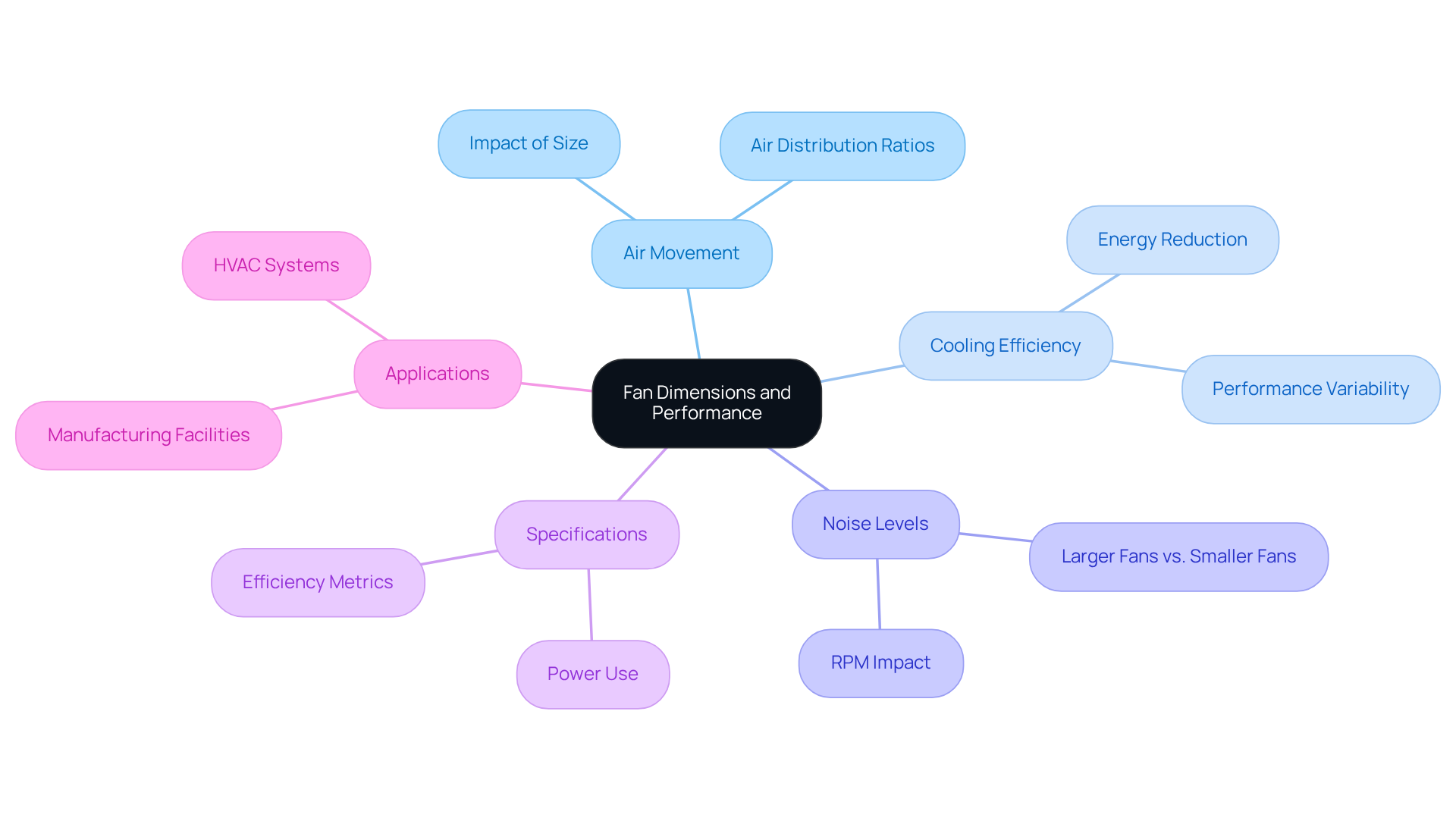
Fan Size Comparison: Choosing the Right Fan for Your Needs
Selecting the appropriate fan for your application necessitates a thorough evaluation of several critical factors, including case size, ventilation requirements, noise tolerance, and consulting a computer fan sizes chart. For general applications, 120 mm cooling devices are exceptionally versatile and suitable for most builds, delivering a balanced airflow and noise level. In high-performance scenarios, 140 mm units are preferred for their ability to circulate more air quietly, making them ideal for demanding thermal conditions. For compact designs, 80 mm and Mini-ITX coolers are optimal, fitting seamlessly into smaller cases without sacrificing performance. Conversely, larger cases benefit from 200 mm units, which offer substantial ventilation and temperature regulation.
Real-world applications exemplify these distinctions: in a recent project, engineers selected 140 mm fans for a gaming rig to ensure optimal thermal management during prolonged use, while a compact workstation incorporated 80 mm fans to maintain a low profile without compromising airflow.
Market analysis reveals an increasing demand for specific fan sizes tailored to diverse applications, with the industrial ceiling fan market anticipated to reach USD 1,036.6 million by 2025, reflecting a compound annual growth rate of 5.9% from 2025 to 2030. This trend highlights the significance of using a to choose the right fan size that satisfies both performance and efficiency standards across various environments. As engineers continue to emphasize effective cooling solutions, grasping these fan size comparisons will be crucial for making informed decisions.
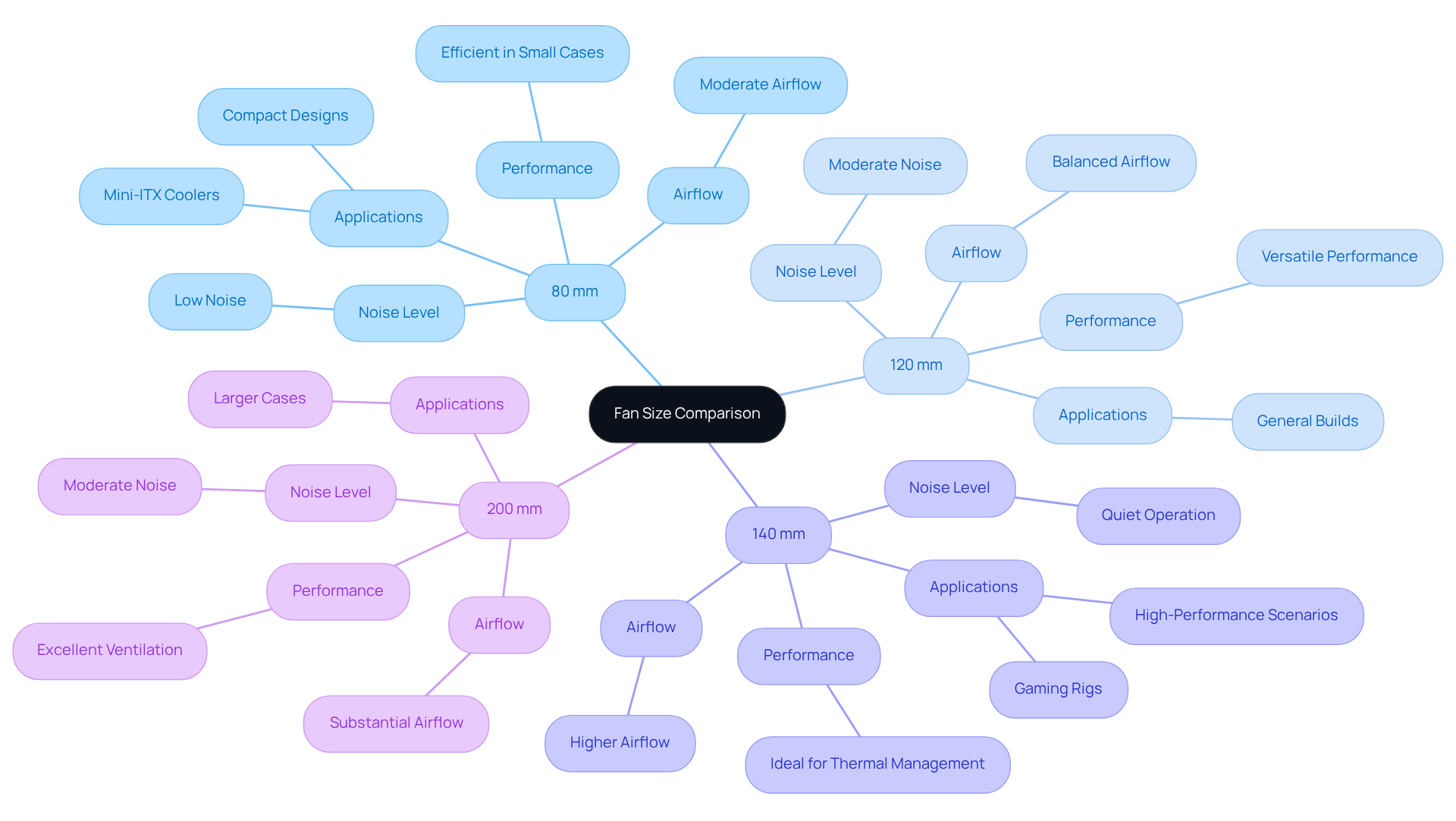
Conclusion
The exploration of computer fan sizes underscores their essential role in effective thermal management within electronic systems. Recognizing the differences among various fan dimensions equips engineers with the critical knowledge to select optimal cooling solutions tailored to specific applications. This understanding is vital for ensuring the reliability and performance of electronic devices, particularly in high-density environments where overheating can precipitate significant failures.
Key insights from the article indicate that:
- 120 mm fans remain the standard for PC cooling, striking a balance between airflow and noise levels.
- 140 mm fans enhance performance in high-demand scenarios.
- Compact solutions, such as 80 mm and Mini-ITX fans, are indispensable for space-constrained builds.
- Larger 200 mm units excel in delivering high airflow for expansive cases.
- Specialized 40 mm fans cater to unique applications, illustrating the diverse needs within the electronics cooling landscape.
As the demand for efficient cooling solutions continues to escalate, it is imperative for engineers to leverage the insights presented in the computer fan sizes chart. By making informed decisions based on fan specifications and performance metrics, professionals can optimize their designs for both cooling efficiency and noise reduction. Embracing these advancements in thermal management not only enhances system reliability but also contributes to the overall sustainability of electronic operations in an increasingly power-conscious world.
Frequently Asked Questions
What is Gagner-Toomey Associates known for?
Gagner-Toomey Associates is recognized as a leading provider of advanced temperature management systems specifically designed for the electronics sector, focusing on innovative technologies that enhance the performance and reliability of electronic systems.
What trends are influencing temperature management in electronics?
The current trends include a shift towards high-end liquid temperature management and energy-efficient technologies, driven by increasing power density in data centers and the miniaturization of electronic devices.
How significant is energy consumption for temperature management in data centers?
Approximately 55% of the total energy consumed in data centers is allocated to maintaining the temperature of IT equipment, highlighting the critical need for effective thermal management solutions.
How can AI-driven optimization impact energy consumption in temperature regulation?
AI-driven optimization of temperature regulation can reduce energy consumption by up to 40%, showcasing the transformative potential of innovative climate control technologies in the electronics sector.
What is the standard fan size for PC cooling, and why is it preferred?
The standard fan size for PC cooling is 120 mm, as it strikes an ideal balance between ventilation and noise levels, operating within a speed range of 1200 to 2000 RPM to provide adequate cooling for various configurations.
What are some notable 120 mm fan models mentioned in the article?
Notable 120 mm fan models include the Corsair iCUE QL120 RGB, which has a maximum ventilation of 41.8 CFM at 26 dBA, and the be quiet! Pure Wings 2, which operates at a peak noise level of 19.2 dBA with an airflow of 51 CFM.
What advantages do 140 mm fans offer over 120 mm fans?
140 mm fans provide superior airflow compared to 120 mm fans, operating within a typical RPM range of 1000 to 1800, making them advantageous for high-performance systems that require efficient thermal management.
Can you name some 140 mm fan models and their features?
The Noctua NF-A14 can reach up to 3000 RPM with an MTBF rating exceeding 70,000 hours, while the Cooler Master Mobius 140P operates at a peak speed of 1900 RPM and features RGB illumination, showcasing both performance and aesthetic benefits.
What is the demand trend for customizable temperature management in high-performance systems?
The adoption of PWM control for customizable temperature management is increasing by 40% annually, indicating a growing need for tailored thermal management solutions in high-performance systems.
What additional options does Gagner-Toomey Associates provide for thermal management?
Gagner-Toomey Associates offers a comprehensive selection of DC input devices, including 140 mm fans, IP protection upon request, and a range of DC input tube axial devices and centrifugal blowers for diverse thermal management applications.

